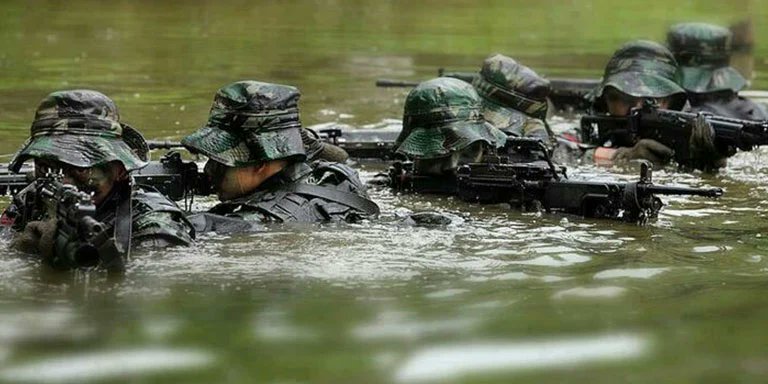
It is 2023, and India-China border disputes are settled with steel.
No guns, only hand weapons.
Reportedly, India has won most engagements. Now, China is formalizing their approach.
1/
No guns, only hand weapons.
Reportedly, India has won most engagements. Now, China is formalizing their approach.
1/
https://twitter.com/LogKa11/status/1621639081007489028
As absurd as this is, it’s real.
Physical border disputes have ignited between soldiers since ~2020.
I’m not very knowledgeable on the political situation, but for some reason firearms are disallowed.
Physical border disputes have ignited between soldiers since ~2020.
I’m not very knowledgeable on the political situation, but for some reason firearms are disallowed.
https://twitter.com/NagarJitendra/status/1602677519626665985
Aside from the fact that we’re somehow seeing Stone Age warfare in the 21st century…
…the fact that China is sending soldiers specially equipped for this sort of fighting means that they’re taking it seriously.
…the fact that China is sending soldiers specially equipped for this sort of fighting means that they’re taking it seriously.
https://twitter.com/BefittingFacts/status/1602684063973707776
The fighting seems to mostly happen at mountain passes, or in otherwise difficult terrain (often at choke points)
It’s also very informal, since soldiers on both sides obviously don’t train for this sort of warfare
(Which is fair, since it hasn’t been relevant in centuries)

It’s also very informal, since soldiers on both sides obviously don’t train for this sort of warfare
(Which is fair, since it hasn’t been relevant in centuries)


There’s also no “riot rules”, wherein clearly lethal weapons are off the table
Both sides regularly take casualties, & between the Chinese maces and Indian spike batons, lethality is clearly a goal.
So basically, this is ancient infantry warfare, in difficult terrain.
Both sides regularly take casualties, & between the Chinese maces and Indian spike batons, lethality is clearly a goal.
So basically, this is ancient infantry warfare, in difficult terrain.
Considering this, the Chinese decision to use a polearm mace seems ridiculous.
While it looks intimidating and is clearly dangerous, it’s not suited for this type of fighting.
Spiked maces are meant for armored opponents, and heavy polearms are best for fighters *in armor*.
While it looks intimidating and is clearly dangerous, it’s not suited for this type of fighting.
Spiked maces are meant for armored opponents, and heavy polearms are best for fighters *in armor*.
They also require a lot of space for effective use (swinging)
If polearms are the Chinese prerogative, they should be using mid-length spears (7-8’), or something like a halberd, naginata, or trident (5-7’)
Maybe with a shield wall, or at least some sort of formation.
If polearms are the Chinese prerogative, they should be using mid-length spears (7-8’), or something like a halberd, naginata, or trident (5-7’)
Maybe with a shield wall, or at least some sort of formation.
The Indian side of things is much more intelligent — for engagements in difficult terrain where formations are difficult, a “sword-and-shield” setup makes sense.
The decision to use electrified weapons is an interesting one, but I can see it being effective.
The decision to use electrified weapons is an interesting one, but I can see it being effective.

They’re also better for dispersed engagements (ie brawls, when formations break)
Which is where this seems to trend toward in many cases
(Think Hollywood-style one-on-one fighting, or rather standard street fighting)
Which is where this seems to trend toward in many cases
(Think Hollywood-style one-on-one fighting, or rather standard street fighting)
In groups, Roman-style tactics might be best here: large shields with one-handed weapons oriented toward thrusting
The Indian tridents + a large, scutum-style riot shield seem like a brutal combo
(The batons are sketchy to me, seems like the spikes would get caught on things)
The Indian tridents + a large, scutum-style riot shield seem like a brutal combo
(The batons are sketchy to me, seems like the spikes would get caught on things)

However, if fighting against Chinese polearms, they should probably wear some armor
With lightweight modern materials, again I think deferring to Rome would be best — chest plate, helmet, armored skirt. Nothing cumbersome
After that, it gets down to effective training.
With lightweight modern materials, again I think deferring to Rome would be best — chest plate, helmet, armored skirt. Nothing cumbersome
After that, it gets down to effective training.
https://twitter.com/0xAlaric/status/1558928790394441729
Thank you to @eviljinious1 for point this out
The world today is stranger than it seems, and I guess knowledge of ancient tactics/weapons isn’t entirely obsolete
The world today is stranger than it seems, and I guess knowledge of ancient tactics/weapons isn’t entirely obsolete
https://twitter.com/eviljinious1/status/1622038046777528322
Poll:
Is this better or worse than modern warfare?
Is this better or worse than modern warfare?
• • •
Missing some Tweet in this thread? You can try to
force a refresh



















